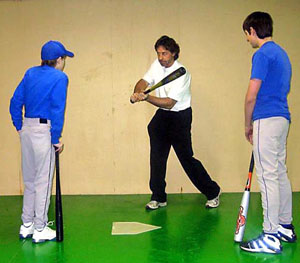
Frequently, I receive this question from my student’s parents, “Should I take him/her to the batting cages.” You would think my response is, “Sure, practice is good.” However, it is not that simple an answer for a number of reasons.
First, and this is often my response, “Let’s wait awhile, because they are just going to revert back to their old habits and we don’t want to reinforce bad habits right now.” Practice is good but perfect practice is much better, so most hitters, who are making swing adjustments, are better off working on their swings with batting tee work or short flip drill work for a period before trying it with the pitched ball. Thinking of hitting mechanics while timing a ball at the same time is very difficult, especially for young ball players.
Second, pitching machine (even those that are of the 3 wheel pitching machines variety) batting cage practice often, just screws up hitters’ timing because they are hitting the same speed pitches the whole time, which is very unrealistic when batting in a game. Of course, if you knew the exact speed of the pitchers they will face in the upcoming games this may be different.
Third, the often consistency of batting cages are not realistic because of the constant strikes they throw, so hitters often get overanxious in games and swing at everything, failing to learn the strike zone.
Having said that, batting machine hitting practice is beneficial when they are used correctly. Often hitters cannot get game like speeds from their coach’s batting practice, so hitting at the local batting cages may be better than no batting practice. Additionally, for hitters who have fear of the ball, pitching machines that throw consistent strikes can help them gain confidence and get over their fears.
Following are tips for how to use pitching machines to get the most benefit.
1. Try to approximate the speed of an average pitcher in the league as closely as possible. Without a radar gun nearby, this may be difficult because often the reported speed of the local batting cages is not correct.
2. When there is a faster-slower adjustment on the controls use it often to help timing and for a more realistic hitting experience, especially as hitters reach the curve ball age. If not, jumping into different speed cages is good.
3. Hitters should begin with a no-stride approach so they can concentrate on seeing the ball and for getting in tune with the timing and rhythm of the machine, without feeling jumpy in the batter’s box.
4. Hitters should move themselves around in the batter’s box often (even for every pitch), when machines are very consistent. This makes the batting practice much more realistic, too, as pitchers are not as consistent as machines. Moving slightly closer to the machine and towards catcher will give higher and lower pitches. Likewise, moving slightly closer to home or farther from home will give more inside and outside pitches to work on.
5. Hitting the ball in the direction of where pitched is always good, as in pitcher-thrown batting practice.
6. Hitters should remember that it is generally easier to “speed ones bat up” in a game then it is to wait for balls when a hitter’s timing is early so working on slower speeds is a good idea, especially to end the hitting session.
7. Along the same lines, players should work predominantly on slow pitches when they are having trouble waiting for balls in games and faster speeds, when they are continually late in games.
Of course, all of these tips are for consistent strike-throwing pitching machines. Inconsistent machines may be more game-like and helpful, but caution of being struck by the ball must be observed with inconsistent machines. Hitters should be careful of using game bats in cages. Often, frequent machine balls can damage aluminum bats quickly. Helmets must be worn, even with consistent pitching machines.










One Response